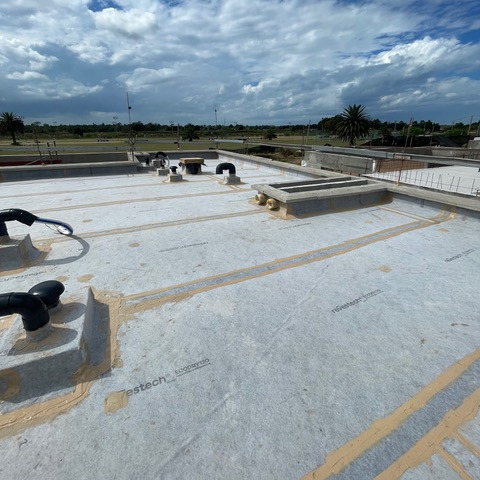THE CHALLENGE OF PROPERLY WATERPROOFING ROOFS AND TERRACES

The challenge of properly waterproofing roofs and terraces is crucial in building construction, as these structures are exposed to the outdoors and require specialized treatments.
Roofs and Terraces – What Are They? What Are the Differences?
Roofs are the structural element of a building that is exposed to the outside air and, as such, require special waterproofing treatments that are specifically designed for each case, taking into account the construction style, the intended use, and the geographical location. If these treatments are not correctly designed or poorly executed, they can lead to serious damage to the building. This is why roof waterproofing systems are critically important and deserve our full attention.
A similar situation arises with terraces and balconies, which, although not typically as complex in design and often covering smaller areas, are considered small roofs when it comes to waterproofing according to current regulations.
Complexities and Uses
When we think of roofs, we might imagine a smooth, open surface, but in reality, they can take on many forms, serve a wide range of uses, and be made from a variety of materials.
Their primary function is to protect the building from external elements that can pose a threat; however, today, they are also considered an additional usable space in the building, providing the opportunity for numerous designs and the potential to create outdoor living spaces where various activities can take place.
What Problems Can Arise When Waterproofing a Roof? Critical Points
Each roof design adopts different construction solutions, but in most cases, there are numerous critical elements that can be easily identified and that require special solutions.
A key point in any building is the waterproofing of the roof, which can be a challenging problem to solve.
Often, we find some general construction solutions that are repeated and provide a global response to these common problems, but many of them have become outdated with the advancement of construction technology and the development of increasingly modern and demanding designs. This is why it is becoming more necessary to incorporate modern, flexible, and adaptable waterproofing systems that take into account the most important particular aspects to provide a customized and correct construction solution.
The most common critical points include intersections with walls or other vertical elements, corners, water drainage elements, drainage pipes or overflow outlets, openings, and more. As the design and use of the space become more complex, the number of critical points requiring special, customized solutions increases. Modern waterproofing systems anticipate these types of solutions by incorporating numerous accessories and guaranteeing a complete and watertight system.
What if I Want to Renovate My Roof?
Everything mentioned above assumes that a roof is being designed from scratch, but often we need to waterproof and provide solutions for roofs in need of renovation.
This is where we can encounter a wide range of critical points and problems to solve, such as cracks, detached tiles, incorrect slopes, outdated water drainage elements, and even old, degraded waterproofing systems. And once again, this is where flexible membranes stand out as one of the most effective and easy-to-install solutions. They do not require special tools or specialized labor for application. They are characterized by being very thin and flexible, with excellent adhesion, highly malleable, and highly resistant to moisture, resulting in 100% watertight protection.
Many of these membranes also offer various solutions to the most common problems found on a roof and serve as a single solution for multiple challenges. For example, waterproofing membranes that also function as vapor barriers, sound barriers, or decoupling layers, among others.
It is very important, when choosing the waterproofing material brand, to select a product with CE marking, which guarantees regulatory compliance, quality, and product durability.
Revestech waterproofing membranes come with a quality mark and adhere to a certified production process, including the traditional DRY line and the ECODRY line, which is committed to the environment by incorporating raw materials from the circular economy, in accordance with the terms of the Environmental Product Declaration.



